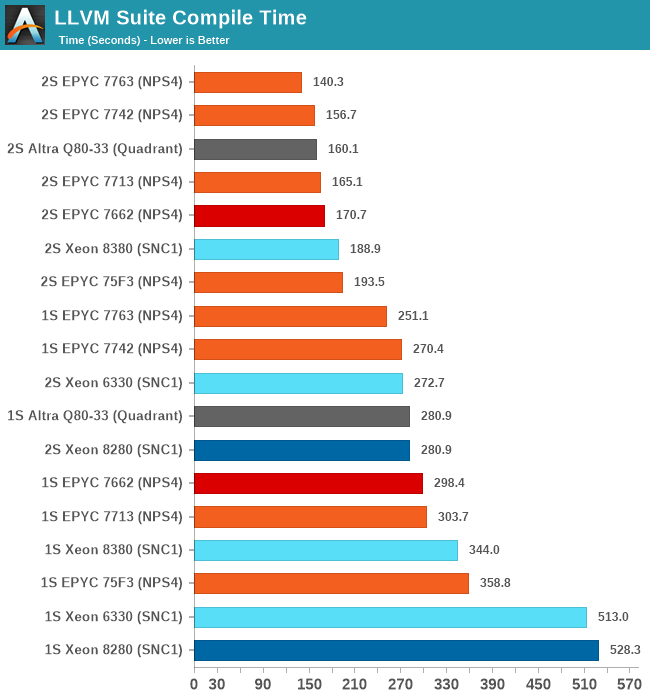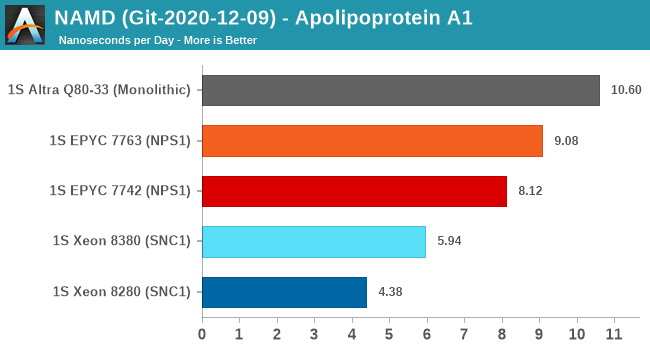Intel 3rd Gen Xeon Scalable (Ice Lake SP) Review: Generationally Big, Competitively Small
by Andrei Frumusanu on April 6, 2021 11:00 AM EST- Posted in
- Servers
- CPUs
- Intel
- Xeon
- Enterprise
- Xeon Scalable
- Ice Lake-SP
Compiling LLVM, NAMD Performance
As we’re trying to rebuild our server test suite piece by piece – and there’s still a lot of work go ahead to get a good representative “real world” set of workloads, one more highly desired benchmark amongst readers was a more realistic compilation suite. Chrome and LLVM codebases being the most requested, I landed on LLVM as it’s fairly easy to set up and straightforward.
git clone https://github.com/llvm/llvm-project.gitcd llvm-projectgit checkout release/11.xmkdir ./buildcd ..mkdir llvm-project-tmpfssudo mount -t tmpfs -o size=10G,mode=1777 tmpfs ./llvm-project-tmpfscp -r llvm-project/* llvm-project-tmpfscd ./llvm-project-tmpfs/buildcmake -G Ninja \ -DLLVM_ENABLE_PROJECTS="clang;libcxx;libcxxabi;lldb;compiler-rt;lld" \ -DCMAKE_BUILD_TYPE=Release ../llvmtime cmake --build .We’re using the LLVM 11.0.0 release as the build target version, and we’re compiling Clang, libc++abi, LLDB, Compiler-RT and LLD using GCC 10.2 (self-compiled). To avoid any concerns about I/O we’re building things on a ramdisk. We’re measuring the actual build time and don’t include the configuration phase as usually in the real world that doesn’t happen repeatedly.

Starting off with the Xeon 8380, we’re looking at large generational improvements for the new Ice Lake SP chip. A 33-35% improvement in compile time depending on whether we’re looking at 2S or 1S figures is enough to reposition Intel’s flagship CPU in the rankings by notable amounts, finally no longer lagging behind as drastically as some of the competition.
It’s definitely not sufficient to compete with AMD and Ampere, both showcasing figures that are still 25 and 15% ahead of the Xeon 8380.
The Xeon 6330 is falling in line with where we benchmarked it in previous tests, just slightly edging out the Xeon 8280 (6258R equivalent), meaning we’re seeing minor ISO-core ISO-power generational improvements (again I have to mention that the 6330 is half the price of a 6258R).

NAMD is a problem-child benchmark due to its recent addition of AVX512: the code had been contributed by Intel engineers – which isn’t exactly an issue in my view. The problem is that this is a new algorithm which has no relation to the normal code-path, which remains not as hand-optimised for AVX2, and further eyebrow raising is that it’s solely compatible with Intel’s ICC and no other compiler. That’s one level too much in terms of questionable status as a benchmark: are we benchmarking it as a general HPC-representative workload, or are we benchmarking it solely for the sake of NAMD and only NAMD performance?
We understand Intel is putting a lot of focus on these kinds of workloads that are hyper-optimised to run well extremely on Intel-only hardware, and it’s a valid optimisation path for many use-cases. I’m just questioning how representative it is of the wider market and workloads.
In any case, the GCC binaries of the test on the ApoA1 protein showcase significant performance uplifts for the Xeon 8380, showcasing a +35.6% gain. Using this apples-to-apples code path, it’s still quite behind the competition which scales the performance much higher thanks to more cores.










169 Comments
View All Comments
mode_13h - Wednesday, April 7, 2021 - link
Intel, AMD, and ARM all contribute loads of patches to both GCC and LLVM. There's no way either of these compilers can be seen as "underdeveloped".And Intel is usually doing compiler work a couple YEARS ahead of each CPU & GPU generation. If anyone is behind, it's AMD.
Oxford Guy - Wednesday, April 7, 2021 - link
It's not cheating if the CPU can do that work art that speed.It's only cheating if you don't make it clear to readers what kind of benchmark it is (hand-tuned assembly).
mode_13h - Thursday, April 8, 2021 - link
Benchmarks, in articles like this, should strive to be *relevant*. And for that, they ought to focus on representing the performance of the CPUs as the bulk of readers are likely to experience it.So, even if using some vendor-supplied compiler with trick settings might not fit your definition of "cheating", that doesn't mean it's a service to the readers. Maybe save that sort of thing for articles that specifically focus on some aspect of the CPU, rather than the *main* review.
Oxford Guy - Sunday, April 11, 2021 - link
There is nothing more relevant than being able to see all facets of a part's performance. This makes it possible to discern its actual performance capability.Some think all a CPU comparison needs are gaming benchmarks. There is more to look at than subsets of commercial software. Synthetic benchmarks also are valid data points.
mode_13h - Monday, April 12, 2021 - link
It's kind of like whether an automobile reviewer tests a car with racing tyres and 100-octane fuel. That would show you its maximum capabilities, but it's not how most people are going to experience it. While a racing enthusiast might be interested in knowing this, it's not a good proxy for the experience most people are likely to have with it.All I'm proposing is to prioritize accordingly. Yes, we want to know how many lateral g's it can pull on a skid pad, once you remove the limiting factor of the all-season tyres, but that's secondary.
Wilco1 - Thursday, April 8, 2021 - link
It's still cheating if you compare highly tuned benchmark scores with untuned scores. If you use it to trick users into believing CPU A is faster than CPU B eventhough CPU A is really slower, you are basically doing deceptive marketing. Mentioning it in the small print (which nobody reads) does not make it any less cheating.Oxford Guy - Sunday, April 11, 2021 - link
It's cheating to use software that's very unoptimized to claim that that's as much performance as CPU has.For example... let's say we'll just skip all software that has AVX-512 support — on the basis that it's just not worth testing because so many CPUs don't support it.
Wilco1 - Sunday, April 11, 2021 - link
Running not fully optimized software is what we do all the time, so that's exactly what we should be benchmarking. The -Ofast option used here is actually too optimized since most code is built with -O2. Some browsers use -Os/-Oz for much of their code!AVX-512 and software optimized for AVX-512 is quite rare today, and the results are pretty awful on the latest cores: https://www.phoronix.com/scan.php?page=article&...
Btw Andrei ran ICC vs GCC: https://twitter.com/andreif7/status/13808945639975...
ICC is 5% slower than GCC on SPECINT. So there we go.
mode_13h - Monday, April 12, 2021 - link
Not to disagree with you, but always take Phoronix' benchmarks with a grain of salt.First, he tested one 14 nm CPU model that only has one AVX-512 unit per core. Ice Lake has 2, and therefore might've shown more benefit.
Second, PTS is enormous (more than 1 month typical runtime) and I haven't seen Michael being very transparent about his criteria for selecting which benchmarks to feature in his articles. He can easily bias perception through picking benchmarks that respond well or poorly to the feature or product in question.
There are also some questions raised about his methodology, such as whether he effectively controlled for AVX-512 usage in some packages that contain hand-written asm. However, by looking at the power utilization graphs, I doubt that's an issue in this case. But, if he excluded such packages for that very reason, then it could unintentionally bias the results.
Wilco1 - Monday, April 12, 2021 - link
Completely agree that Phoronix benchmarks are dubious - it's not only the selection but also the lack of analysis of odd results and the incorrect way he does cross-ISA comparisons. It's far better to show a few standard benchmarks with well-known characteristics than a random sample of unknown microbenchmarks.Ignoring all that, there are sometimes useful results in all the noise. The power results show that for the selected benchmarks there is really use of AVX-512. Whether this is typical across a wider range of code is indeed the question...